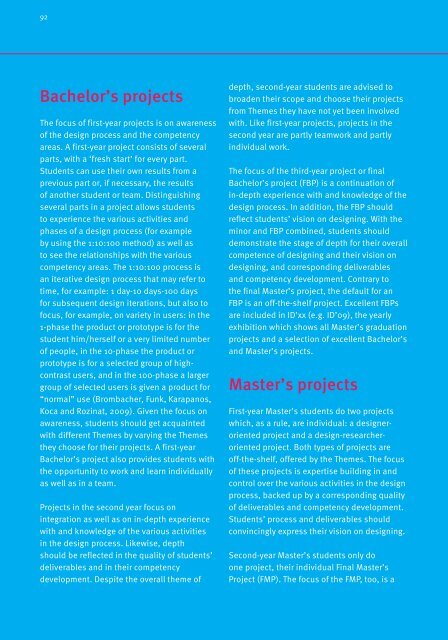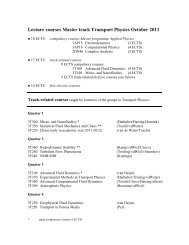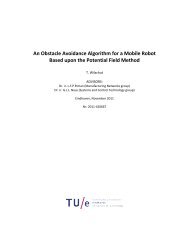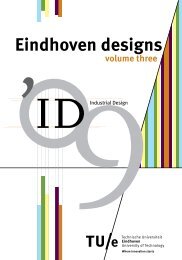Education guide 'Eindhoven designs' - Technische Universiteit ...
Education guide 'Eindhoven designs' - Technische Universiteit ...
Education guide 'Eindhoven designs' - Technische Universiteit ...
Create successful ePaper yourself
Turn your PDF publications into a flip-book with our unique Google optimized e-Paper software.
92<br />
Bachelor’s projects<br />
The focus of first-year projects is on awareness<br />
of the design process and the competency<br />
areas. A first-year project consists of several<br />
parts, with a ‘fresh start’ for every part.<br />
Students can use their own results from a<br />
previous part or, if necessary, the results<br />
of another student or team. Distinguishing<br />
several parts in a project allows students<br />
to experience the various activities and<br />
phases of a design process (for example<br />
by using the 1:10:100 method) as well as<br />
to see the relationships with the various<br />
competency areas. The 1:10:100 process is<br />
an iterative design process that may refer to<br />
time, for example: 1 day-10 days-100 days<br />
for subsequent design iterations, but also to<br />
focus, for example, on variety in users: in the<br />
1-phase the product or prototype is for the<br />
student him/herself or a very limited number<br />
of people, in the 10-phase the product or<br />
prototype is for a selected group of highcontrast<br />
users, and in the 100-phase a larger<br />
group of selected users is given a product for<br />
“normal” use (Brombacher, Funk, Karapanos,<br />
Koca and Rozinat, 2009). Given the focus on<br />
awareness, students should get acquainted<br />
with different Themes by varying the Themes<br />
they choose for their projects. A first-year<br />
Bachelor’s project also provides students with<br />
the opportunity to work and learn individually<br />
as well as in a team.<br />
Projects in the second year focus on<br />
integration as well as on in-depth experience<br />
with and knowledge of the various activities<br />
in the design process. Likewise, depth<br />
should be reflected in the quality of students’<br />
deliverables and in their competency<br />
development. Despite the overall theme of<br />
depth, second-year students are advised to<br />
broaden their scope and choose their projects<br />
from Themes they have not yet been involved<br />
with. Like first-year projects, projects in the<br />
second year are partly teamwork and partly<br />
individual work.<br />
The focus of the third-year project or final<br />
Bachelor’s project (FBP) is a continuation of<br />
in-depth experience with and knowledge of the<br />
design process. In addition, the FBP should<br />
reflect students’ vision on designing. With the<br />
minor and FBP combined, students should<br />
demonstrate the stage of depth for their overall<br />
competence of designing and their vision on<br />
designing, and corresponding deliverables<br />
and competency development. Contrary to<br />
the final Master’s project, the default for an<br />
FBP is an off-the-shelf project. Excellent FBPs<br />
are included in ID’xx (e.g. ID’09), the yearly<br />
exhibition which shows all Master’s graduation<br />
projects and a selection of excellent Bachelor’s<br />
and Master’s projects.<br />
Master’s projects<br />
First-year Master’s students do two projects<br />
which, as a rule, are individual: a designeroriented<br />
project and a design-researcheroriented<br />
project. Both types of projects are<br />
off-the-shelf, offered by the Themes. The focus<br />
of these projects is expertise building in and<br />
control over the various activities in the design<br />
process, backed up by a corresponding quality<br />
of deliverables and competency development.<br />
Students’ process and deliverables should<br />
convincingly express their vision on designing.<br />
Second-year Master’s students only do<br />
one project, their individual Final Master’s<br />
Project (FMP). The focus of the FMP, too, is a

















